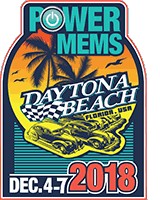  |
PowerMEMS School Summary 08:40 - 09:25 09:25 - 10:10 10:30 - 11:15 11:15 - 12:00 13:30 - 14:15 14:15 - 15:00 15:20 - 16:05 16:05 - 16:50 |
Thermoelectric Energy Harvesters: Principles, Materials and Devices
Armin Feldhoff Extraordinary Professor at the Faculty of Natural Sciences of the Leibniz, Universität Hannover, Germany
Abstract
A thermoelectric harvester converts thermal power into electrical power. Thermoelectric energy harvesting relies on the thermal induction of an electrical current in an all-solid device without moving parts. It uses an entropy current to drive an electrical current. Depending on the sign of the Seebeck coefficient α of the material, both currents are parallel or anti-parallel. The serial connection of n-type (α < 0) and p-type (α > 0) semiconducting legs with their contacts being alternatingly hot and cold, allows constructing thermoelectric modules, which can make use of the entropy current running from "hot" to "cold" for energy harvesting [1]. Materials and generators can be either designed for the maximum power conversion efficiency or maximum electrical power output [2]. In the first case, the thermoelectric figure-of-merit, which depends on three material parameters (Seebeck coefficient α, electrical conductivity σ, entropy conductivity Λ) must be maximized. If these three parameters are known for the thermoelectric materials, their performance in a thermoelectric generator can be predicted from finite-element methods simulations [3]. In the second case, the power factor, which depends only on the Seebeck coefficient α and the electrical conductivity σ, must be maximized. Generalized Ioffe plots (electrical and thermal) help to choice proper materials. The basic principles of thermoelectrics and choice of materials are reviewed in an educative manner. Moreover, the actual situation of thermoelectric generators based on microelectromechanical systems (MEMS) technology is illuminated.
[1] A. Feldhoff, Thermoelectric material tensor derived from the Onsager - de Groot - Callen model, Energy Harvesting and Systems 2 (2015) 5-13, doi: 10.1515/ehs-2014-0040. [2] A. Feldhoff, Direct entropic approach to power conversion and its efficiency in thermoelectric materials (manuscript in preparation). [3] B. Geppert, D. Groeneveld, V. Loboda, A. Korotkov, A. Feldhoff, Finite-element simulations of a thermoelectric generator and their experimental validation, Energy Harvesting and Systems, 2 (2015) 95-104, doi: 10.1515/ehs-2015-0001 
About the Speaker
Dr. Feldhoff's research interests are in thermo-iono-electric (TIE) materials for energy conversion. His activities link materials synthesis with the microstructure, as obtained by scanning and transmission electron microscopy as well as x-ray diffraction, and functionality. Aim is always a knowledge-based approach to bring new functionality into materials and devices. He has published more than 150 papers in peer-reviewed journals. Actually, his h-index is 41 with more than 6,000 citations. Dr. Feldhoff received his diploma in physics from the University of Münster (Germany) and received his PhD degree from the Martin-Luther University Halle-Wittenberg (Germany). He was pre- and post-doctoral researcher at the Max Planck Institute of Microstructure Physics in Halle (Germany). He was postdoctoral associate at the Department of Materials Science and Engineering at Cornell University in Ithaca (NY, USA) and at the Centre d'Études de Chimie Métallurgique of the CNRS in Vitry sur Seine (France). He is head of the Nanostructure Laboratory at the Institute of Physical Chemistry and Electrochemistry of the Leibniz Universität Hannover (Germany) and holds the venia legendi for Physical Chemistry. In the German Society for Electron Microscopy, he is serving in the editorial team of Electron Microscopy. He is acting as associate editor of both Energy Harvesting & Systems and the Journal of Electronic Materials. |